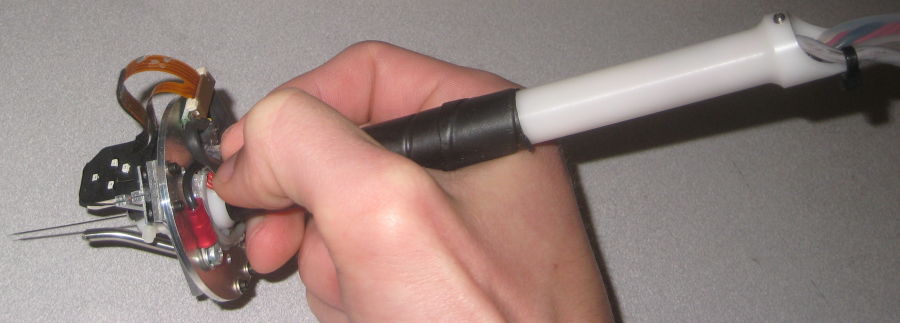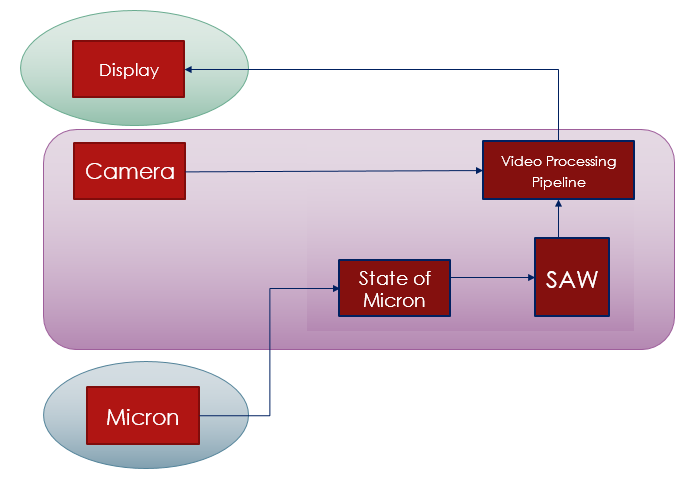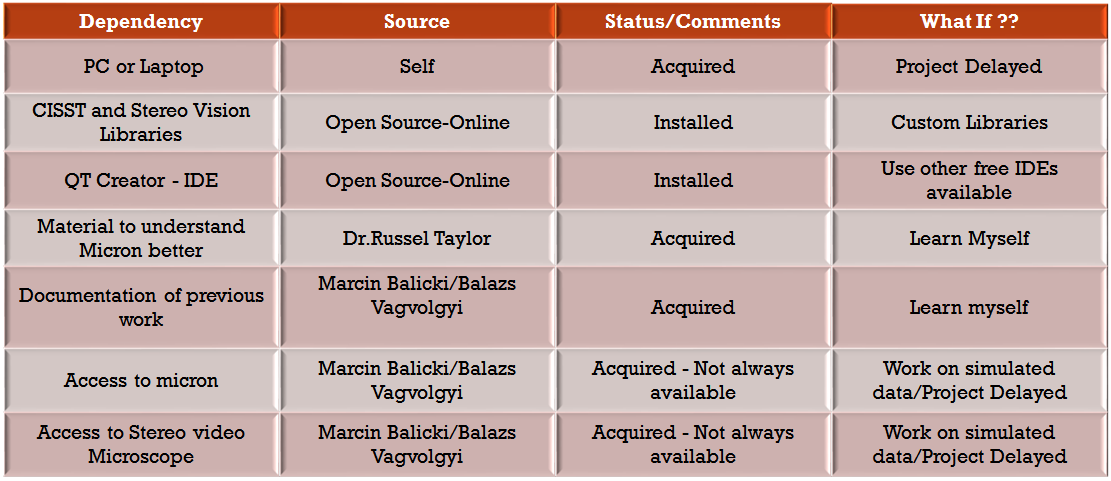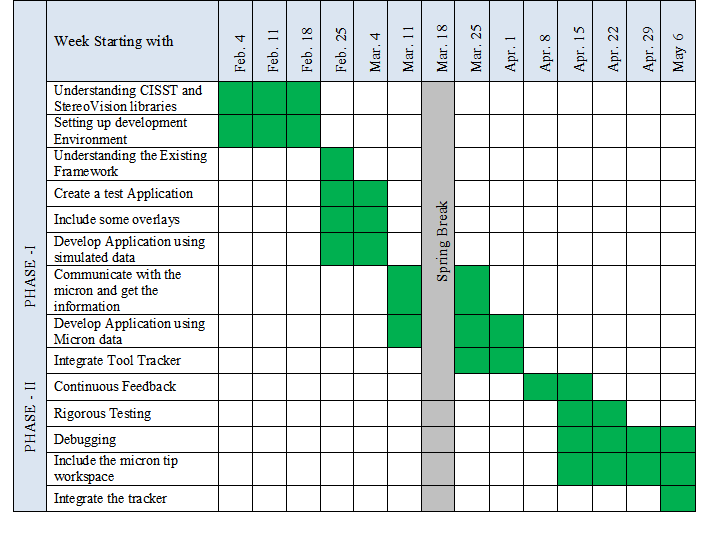Table of Contents
Micron Range-of-Motion Visualization
Last updated: 5/10/2013
Summary
Micron is a fully handheld microsurgical tool, which provides the surgeon a method to more precisely control µ-level hand movements. However, when the micron tip goes out of its workspace, it stars moving erratically. Surgeons, while performing critical surgeries like retinal microsurgery, would want to have a visual feedback system, which helps them to stay within the range of motion.
In this project my main objective is to develop an efficient audio and visual assistance system for the surgeons to help them give a clear view of the position of the tip of the micron.
- Student: Preetham Chalasani
- Mentor(s): Dr.Russell Taylor, Balazs Vagvolgyi, Marcin Balicki
Background, Specific Aims, and Significance
Peeling delicate retinal membranes, which are often less than five microns thick, is one of the most challenging retinal surgeries. Preventing rips and tears caused by tremor and excessive force can decrease injury and reduce the need for follow up surgeries. So to address issues in the delicate micromanipulation of retinal membranes, a fully handheld micromanipulator, Micron was developed in the lab at Carnegie Mellon University, Pittsburgh.
Significance and Importance
Microsurgical tools play a very significant role in very small and critical anatomies. Tremor compensation is a key component of many surgical robots and tries to eliminate the frequency bands dominated by tremor in order to remove unwanted motion while preserving the operators’ intended movements. Micron is one such microsurgical tool. It has been developed with actuators not on robot arm, but between the handle grip and the tool tip. Micron can move the tool tip independently of the hand motion, allowing it to perform behaviors such as tremor reduction, motion scaling and virtual fixtures.
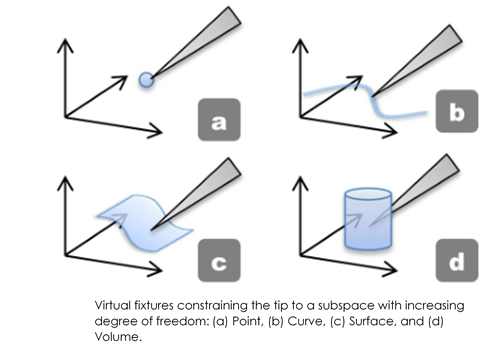
Deliverables
Following are the deliverables that were discussed at the
beginning of the semester, which have been successfully
implemented and tested:-
Minimum Deliverables
- Develop a test application with some overlays.
- Test the application with random simulated data.
- Communicate with the micron and retrieve the information
- Display the information according on the overlays
Expected Deliverables
- Develop the visual assistance system
- Develop an overlay to display depth of the micron tip
- Integrate the tool tracker into the application
- Get feedback from the surgeons
Maximum Deliverables
- Audio Feedback
- Develop an overlay to display the workspace of the micron
- Conduct rigorous testing
Technical Approach
Phase I
- Installation :- Installing all the dependent librarires like cisst, openCV etc.
- Circle Overlay :- This overlay will help surgeon see the micron tip position relative to its home position.
- Painter Test, for playing around with the circle overlay, mimicking micron tip with mouse.
- Alert System, which will consist of only the circle overlay.
- Circle Overlay for Home position of the micron
- Random data from micron Interface
Phase II
- Audio Feedback
- Cube Workspace
- Set Asap Orientation manually
- Develop ASAP gui
- Depth display bar
- Set Scaling Value
Kindly go through the final report attached below, for detailed description.
Flow Diagram
Dependencies
Timeline
Milestones and Status
- Milestone name: Test Application
- Planned Date: Feb 25
- Expected Date: March 11
- Status: Completed
- Milestone name: Overlays
- Planned Date: Feb 25
- Expected Date: March 11
- Status: Completed
- Milestone name: Simulate micron Data and test
- Planned Date: Feb 25
- Expected Date: March 11
- Status: Completed
- Milestone name: Develop Application based on Simulated data
- Planned Date: Feb 25
- Expected Date: March 11
- Status: Completed
- Milestone name: Getting Information From Micron
- Planned Date: March 12
- Expected Date: March 31
- Status: Completed
- Milestone name: Develop Application based on Micron data
- Planned Date: Feb 12
- Expected Date: March 31
- Status: Completed
- Milestone name: Continuous FeedBack
- Planned Date: April 1
- Expected Date: April 15
- Status: Completed
- Milestone name: Rigorous Testing
- Planned Date: April 9
- Expected Date: April 15
- Status: Completed
- Milestone name: Debugging
- Planned Date: April 15
- Expected Date: May 6
- Status: Completed
- Milestone name: Micron Tip Workspace
- Planned Date: April 15
- Expected Date: May 6
- Status: Completed
- Milestone name: Integrate Tracker
- Planned Date: May 1
- Expected Date: May 6
- Status: Completed
Problems Faced
- Access to micron – Not always did I have the access to the micron.
- Build/ Compile delay – There are a lot of sleeps in the code, which delays the build time, as well as the compile time.
- 3D rendering of cube – Initially, I tried to render a 3D cube instead of a isometric projection of a 3D cube, which was a bit problematic, since cisst doesn’t support 3D rendering. Also, trying to integrate OSG(open scene graph) at the last moment was a bit risky.
- Integration of the tool-tracker
Reports and Presentations
- Project Plan
- Project Checkpoint
- Paper Seminar Presentations
- Project Final Presentation
- Project Final Report
Acknowledgements
I would like to thank my mentors, Dr.Russel Taylor, Marcin Balicki and Balzs Vagvolgyi, for their support
throughout the project. Their input and guidance was immeasurable. I would specially like to thank Balazs for his valuable help and suggestions along the way.
Project Bibliography
[1] B. C. Becker, S. Voros, R. A. MacLachlan, G. D. Hager, and C. N. Riviere, “Active Guidance of a Handheld Micromanipulator using Visual Servoing”, in IEEE International Conference on Robotics and Automation, Kobe, Japan, May 12-17, 2009. pp. 339-344.
[2] B. Becker, R. MacLachlan, and C. Riviere, “State estimation and feedforward tremor suppression for a handheld micromanipulator with a Kalman filter”, in EEE RSJ Int Conf Intell Robot Syst, 2011. pp. 5160-5165. NIHMSID: 345014.
[3] B. Becker, R. MacLachlan, L. Lobes, and C. Riviere, “Vision-Based Retinal Membrane Peeling with a Handheld Robot”, in IEEE Int Conf Robot Autom, 2012. pp. 1075-1080. NIHMSID: 368417.
[4] B. Becker, S. Yang, R. MacLachlan, and C. Riviere, “Towards vision-based control of a handheld micromanipulator for retinal cannulation in an eyeball phantom”, in Proc IEEE RAS EMBS Int Conf Biomed Robot Biomechatron, 2012. p. accepted for publication. NIHMSID: 368431.
[5] B. Gonenc, M. A. Balicki, J. Handa, P. Gehlbach, C. N. Riviere, R. H. Taylor, and I. Iordachita, “Preliminary Evaluation of a Micro-Force Sensing Handheld Robot for Vitreoretinal Surgery”, in IEEE/RSJ International Conference on Intelligent Robots and Systems (IROS), Vilamoura, Algarve, Portugal, 7-12 October, 2012. pp. 4125-4130.
[6] R. MacLachlan, B. Becker, J. Cuevas-Tabarés, G. Podnar, L. Lobes, and C. Riviere, “ Micron: an actively stabilized handheld tool for microsurgery”, IEEE Trans Robot., vol. 28- 1, pp. 195-212, 2012. NIHMSID:345015.
[7] S. Yang, M. Balicki, R. A. MacLachlan, X. Liu, J. U. Kang, R. H. Taylor, and C. N. Riviere, “Optical Coherence Tomography Scanning with a Handheld Vitreoretinal Micromanipulator ”, in IEEE Engineering in Medicine and Biology Conf, San Diego, Aug 28-Sep 1, 2012. pp. 948-951. NIHMSID: 383510.
[8] S. Yang, R. MacLachlan, and C. Riviere, “Design and analysis of 6 DOF handheld micromanipulator”, in Proc IEEE Int Conf Robot Autom., St. Paul, MN, May 14-18, 2012. pp. 1946-51. NIHMSID: 368427.
[9] B. Becker, R. MacLachlan, L. Lobes, G. Hager, and C. Riviere, “Vision-Based Control of a Handheld Surgical Micromanipulator with Virtual Fixtures”, IEEE Transactions on Robotics, pp. Acepted Nov 27, 2012, 2013. NIHMSID: 429749.
[10] M. Balicki, J.-H. Han, I. Iordachita, P. Gehlbach, J. Handa, R. H. Taylor, and J. Kang, “Single Fiber Optical Coherence Tomography Microsurgical Instruments for Computer and Robot-Assisted Retinal Surgery”, in Medical Image Computing and Computer Assisted Surgery (MICCAI 2009), London, September 20-24, 2009. pp. 108-115. PMID: 20425977
Other Resources and Project Files
CISST
Eye-BRP
My Bitbucket Repo
Username/Password Required for Eye-Brp Only Authorized users can access by repo
Download
To download all the files regarding this project, please click on the below link
